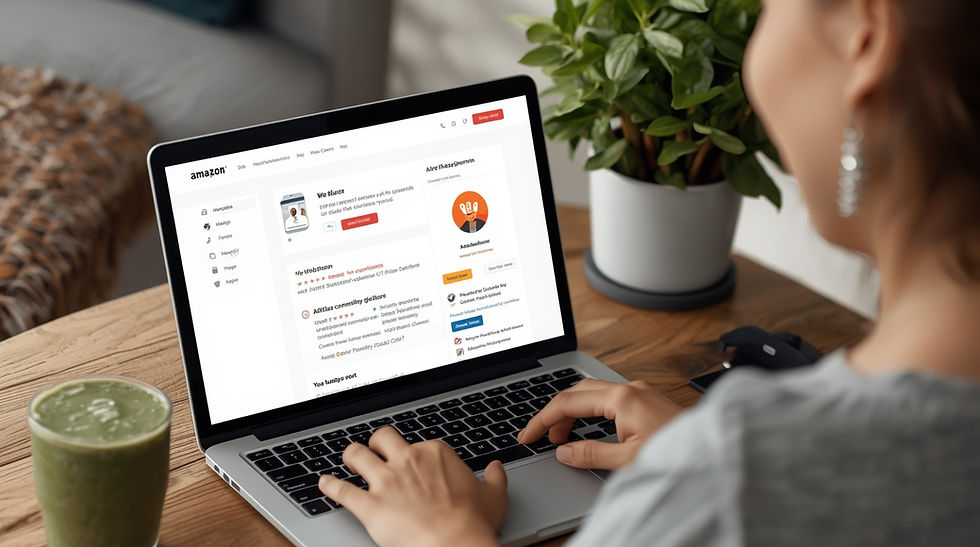7 Affiliate Marketing Strategies for Food Bloggers on a Budget
- MTK Marketing LLC
- Sep 10
- 8 min read
Updated: Sep 10
Disclosure: I may earn a small commission for purchases made through affiliate links in this post at no extra cost to you. I only recommend products I truly believe in. Thank you for supporting my site!

You pour your heart into your food blog. You spend hours developing the perfect recipe, styling the photos, and writing engaging content. You've built a loyal following that trusts your taste. But that trust, that effort—can it actually pay the bills?
For food bloggers, affiliate marketing is one of the most accessible and effective ways to generate income. But the thought of it can be daunting. You might imagine you need a huge audience, expensive tools, or a background in sales. Nothing could be further from the truth.
With strategic planning and a focus on authenticity, you can start earning affiliate income from your food blog right now, even on a tight budget. It's not about selling out; it's about sharing the very tools and ingredients that help you create the magic your audience loves.
This guide will walk you through seven budget-friendly affiliate marketing strategies designed specifically for food bloggers. We'll cover everything from leveraging your pantry to partnering with meal kit services, all without requiring a massive audience or upfront investment.
1. Master the Art of the "Pantry Staples" Post
Your most powerful affiliate assets are already in your kitchen cabinet. Pantry staples are the ultimate evergreen affiliate topic because people constantly need to restock them.
How It Works: Instead of just listing ingredients in a recipe, you create dedicated content around the core items you use and love.
Budget-Friendly Tactics:
Create "Best Of" Guides: Write posts like "The Only 5 Olive Oils You'll Ever Need" or "My Go-To Spices for Global Cuisine." In these posts, you can explain why you choose certain brands (e.g., cold-pressed, ethically sourced, best value) and link to them.
Ingredient Spotlights: Dedicate a blog post to a single ingredient. For example, "A Complete Guide to Nutritional Yeast: What It Is, How to Use It, and My Favorite Brand." This allows for multiple affiliate links within a single, valuable piece of content.
Amazon Lists are Your Friend: Use Amazon's "List" feature to create a "My Blog's Pantry" list. Add all your favorite staples. Then, embed this list on a dedicated "Shop My Pantry" page on your blog and link to it from your recipe posts. This is a huge time-saver.
Affiliate Programs to Join:
Amazon Associates: The obvious choice for a vast range of pantry items.
Thrive Market: Perfect for bloggers focused on organic, paleo, keto, or specialty diets. Their affiliate program offers commissions on memberships and product sales.
Brand-Specific Programs: Many premium brands (like Bob's Red Mill, San Marzano tomatoes, or King Arthur Flour) have their own affiliate programs. Check the footer of their websites for "Affiliate" links.

2. Leverage Your Recipe Content (The Seamless Integration)
Your recipes are your main attraction. This is where your audience is most engaged, making it the perfect place for subtle, helpful affiliate links.
How It Works: You integrate affiliate links directly into your recipe content where they provide genuine utility to the reader.
Budget-Friendly Tactics:
Link to Specific Equipment: When you write "chop the onions," link those words to your favorite, affordable chef's knife on Amazon. When you say "blend until smooth," link to the specific model of blender you use.
"Shop the Post" Galleries: At the top or bottom of your recipe post, use a plugin like Tasty Pins to create a beautiful gallery of the key equipment and ingredients used in the recipe, each with an affiliate link. This is incredibly effective and visually appealing.
Be an Expert, Not a Salesperson: Your language is key. Don't say "Buy this knife." Say, "I've used this Victorinox Fibrox Chef's Knife for years. It's an affordable, razor-sharp workhorse that makes prep work a breeze. It's the best value for money I've found." This builds trust and justifies the recommendation.
Affiliate Programs to Join:
Amazon Associates: For kitchen tools, small appliances, and specific ingredients.
Target Affiliate Program: Great for linking to more common, grocery-store-friendly brands and tools.

3. Create "Gift Guide" Content for Every Occasion
Gift guides are affiliate marketing powerhouses. They have a long shelf life and rank well on Google, especially during holidays.
How It Works: You curate lists of the best gifts for specific types of people or occasions related to your niche.
Budget-Friendly Tactics:
Niche Down: Don't create a generic "Holiday Gift Guide." Create specific ones like "Gifts for the Beginner Sourdough Baker," "Christmas Gifts for the Instant Pot Lover," or "Valentine's Day Gifts for Chocolate Lovers."
Include a Range of Price Points: Always include budget-friendly options ($10-$25) alongside higher-ticket items. This makes your guide accessible to all your readers.
Promote Year-Round: Gift guides aren't just for November and December. Create them for Mother's Day, Father's Day, birthdays, and wedding season.
Affiliate Programs to Join:
Amazon Associates: The king of gift guides.
Etsy: Perfect for finding unique, handmade kitchen tools, linens, and food-related gifts. Their affiliate program is robust.
Food52 Shop: Carries beautiful, curated kitchenware and offers an affiliate program.

4. Develop "Meal Planning" and "Beginner Kitchen" Resources
Your expertise goes beyond recipes. Teach your audience how to cook and organize, and recommend the tools to help them do it.
How It Works: You create foundational content that helps people solve a bigger problem, like "how to get weeknight dinner on the table" or "how to stock a kitchen."
Budget-Friendly Tactics:
Meal Planning Templates: Create a free downloadable meal planning PDF. Within the PDF and the blog post where it's offered, recommend affordable ingredients and tools that make meal planning easier.
"Kitchen Essentials on a Budget" Guide: Write the ultimate post on equipping a kitchen without spending a fortune. This is a perfect place to link to your favorite affordable knife, cutting board, mixing bowls, and sheet pans.
Video Content: Use your phone to create short videos showing how you use your recommended tools. A quick video of you efficiently using a good knife is more powerful than any written description.
Affiliate Programs to Join:
Amazon Associates: For all basic kitchen tools.
Retailers like Walmart or WebstaurantStore: Often have great prices on commercial-grade basics (like sheet pans and mixing bowls) and have affiliate programs.

5. Partner with Meal Kit and Grocery Delivery Services
Meal kit services have generous affiliate programs because they have high customer lifetime values.
How It Works: You promote a meal kit service you've tried and enjoyed, offering your audience a discount on their first box.
Budget-Friendly Tactics:
Be Honest About Your Experience: Write a detailed, balanced review. Who is the service best for? (e.g., busy families, couples, singles). What are the pros and cons? Your authenticity will convert much better than a generic banner ad.
Create Recipe-Specific Content: "How I Dress Up My HelloFresh Meals in 10 Minutes" or "5 Easy Swaps to Make Your Blue Apron Meal Healthier." This provides unique value and a natural place for affiliate links.
Offer an Exclusive Deal: Most meal kit services provide affiliate partners with a special discount code to share. This gives your readers an extra incentive to use your link.
Affiliate Programs to Join:
HelloFresh: Consistently ranked as one of the best affiliate programs for food bloggers, with high commissions.
Home Chef, Blue Apron, EveryPlate: All have strong affiliate programs. It's worth joining several and promoting the one you personally like best.

6. Utilize YouTube and Pinterest for Visual Product Demonstrations
If a picture is worth a thousand words, a video is worth a thousand affiliate clicks. You don't need a fancy camera—your smartphone is enough.
How It Works: You create short, engaging video content that showcases your affiliate products in action.
Budget-Friendly Tactics:
Pinterest Idea Pins: Create short video tutorials (under 60 seconds) showing a kitchen hack using a specific tool. For example, "3 Ways to Use a Microplane" or "Why I Never Cook Without My Fish Spatula." Link directly to the product in the pin.
YouTube Shorts/Reels: Film a quick "unboxing" of a new ingredient you're excited about or a "one-minute review" of a kitchen gadget. In the video description, include your affiliate link.
Behind-the-Scenes Content: Show yourself using your favorite tools while you develop a recipe. This authentic integration is highly effective.
Affiliate Programs to Join:
All of the above! Use video to promote the same pantry staples, kitchen tools, and meal kits.
7. Build a "Shop" Page and Interlink Strategically
Don't make your readers hunt for your recommendations. Create a centralized hub that showcases all your favorite products.
How It Works: You create a dedicated page on your blog that acts as a curated storefront.
Budget-Friendly Tactics:
Create Themed Pages: Instead of one giant page, create several:
"My Kitchen Equipment"
"My Baking Essentials"
"My Favorite Pantry Staples"
"Meal Kit Discounts"
Interlink Like a Pro: Within your recipe posts, whenever you mention a tool or ingredient, link directly to its listing on your "Shop" page. This keeps readers on your site and dramatically increases the chance of an affiliate sale.
Promote in Your Newsletter: Regularly feature a "Product of the Week" from your shop page in your email newsletter to your most engaged audience.
Affiliate Programs to Join:
Use a Link Management Tool: A free tool like Pretty Links (WordPress plugin) helps you create clean, manageable affiliate links for your shop pages (e.g., yourblog.com/recommends/knife).
Your Affiliate Marketing Questions, Answered
Q1: What are the best affiliate programs for food bloggers?
A: Start with these reputable networks:
Amazon Associates: The biggest, with millions of products. Commissions are low (often 1-4%), but conversion is high because everyone shops on Amazon.
ShareASale: Features thousands of merchants, including many kitchenware brands like KitchenAid, OXO, and Lodge Cast Iron.
CJ Affiliate: Another large network with major brands like Betty Crocker and Hershey’s.
Individual Brand Programs: Many companies, like Target and Thrive Market, run their own affiliate programs with often higher commission rates.
Q2: How much can a food blogger make with affiliate marketing?
A: Income varies wildly. A new blogger might make $50-100/month. A mid-tier blogger with a dedicated audience can make $1,000-$5,000/month. Top food bloggers easily earn six figures annually from affiliates alone. It depends on your traffic, niche, and how strategically you implement these tactics.
Q3: Do I need a huge audience to start?
A: Absolutely not. A small, highly-engaged audience is far more valuable than a large, passive one. Focus on building a community that trusts you, even if it's just a few hundred people. They are much more likely to click your links and buy based on your recommendation.
Q4: What’s the biggest mistake new affiliate marketers make?
A: Promoting too many products too soon. This makes your site look spammy and destroys reader trust. Start with one or two programs and a handful of products you genuinely believe in. Quality over quantity always wins.
Final Thoughts: Your Trust is Your Greatest Asset
As a food blogger, your audience trusts your palate and your opinion. That trust is the foundation of successful affiliate marketing. By focusing on these budget-friendly strategies and always prioritizing genuine recommendations over quick commissions, you can build a sustainable income stream that feels authentic and rewarding.
Start with one strategy. Master it. Then move on to the next. Before you know it, your blog will not only be a source of delicious recipes but also a thriving business.
Your assignment: Pick one strategy from this list. This week, create one piece of content for it—a pantry staples post, a dedicated shop page, or a meal kit review. Take that first step.
For more on managing your blogging income, learn how to create a realistic budget that works for variable income.



Comments